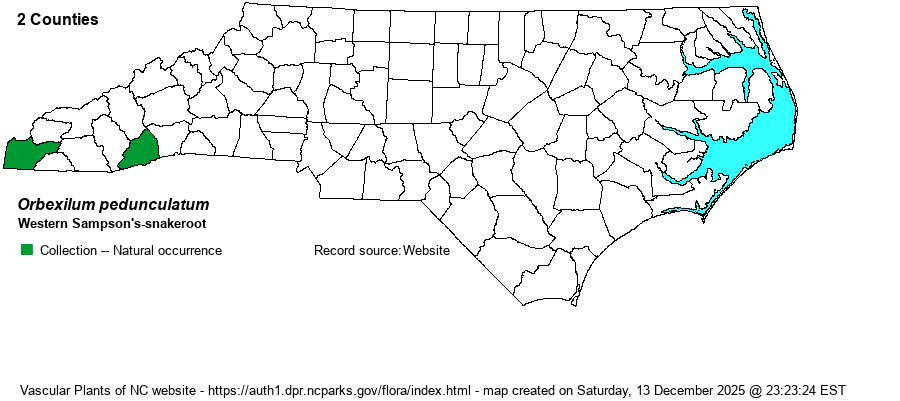| Author | (P. Miller) Rydberg | |
| Distribution | Known only from the southern Mountains (Cherokee and Transylvania counties), and currently considered to exist only in Cherokee County. It has been found in several sites in that county, including in recent years. There has been much taxonomic argument about the status of this taxon and O. psoralioides (strict sense). Most of the SERNEC specimens for "O. pedunculatum" clearly refer to O. psoralioides, as the first species is known to be a Midwestern species ranging east barely to southwestern NC.
This is the western portion range of Orbexilum psoralioides as shown on the BONAP map. Weakley (2018) says that it has a range from "S. OK, s. IN, s. IL, c. MO, and se. KS, south to sw. NC, sc. SC, sw. GA, w. Panhandle FL, s. AL, s. LA, and e. TX". | |
| Abundance | Rare in the western half of Cherokee County; otherwise not now known to be present in NC. The NCNHP lists this with a State Rank of S1; it is State Endangered. | |
| Habitat | This species occurs in mesic open woodlands, but a few NC sites are in damp ground in partial shade. Farther to the west, it can occur in prairies and glades, as well as in open woods. There may be a slight affinity for circumneutral soils, but this is not clear for NC. | |
| Phenology | Blooms from May to July, and fruits from July to September. | |
| Identification | This species is very similar to O. psoralioides in appearance. It has an erect or slightly leaning stem up to about 1.5 feet tall, mostly unbranched or with one or two strongly ascending to erect branches. There are rather few leaves, each consisting of 3 leaflets, with each one of them being narrowly elliptic and about 2 inches long but just 2/5-inch wide. The petioles are somewhat long, at close to 1 inch long. The species is conspicuous when in bloom, as the flowering stalks are often 5-6 inches tall, with the last 2 inches being covered in a very dense spike or tight raceme of violet-blue to lavender-blue flowers. O. psoralioides differs in many subtle characters, particularly in that its calyx tube, fruits, inflorescence bracts, and leaflet undersides have glands (sticky to the touch), whereas O. pedunculatum species is not glandular on these parts. You may need a hand lens to check these, but normally a glandular surface will feel sticky when squeezed. The ranges of these two are not known to overlap in NC, with O. pedunculatum known only from the southern mountains, so far. | |
| Taxonomic Comments | During much of the 20th Century, it was included in the genus Psoralea. RAB (1968) treated it as a variety -- P. psoralioides var. eglandulosa, which is a synonym of O. psoralioides var. psoralioides. Now, Weakley and a few other authorss have elevated it as a good species.
| |
| Other Common Name(s) | The collective taxa of O. psoralioides and/or O. pedunculatum are almost always named as "Sampson's-snakeroot". Thus, the split requires a modifier name, here (and in Weakley 2018) named as Western Sampson's-snakeroot. | |
| State Rank | S1 | |
| Global Rank | G5? | |
| State Status | E | |
| US Status | | |
| USACE-agcp | FACU link |
| USACE-emp | FACU link |

